Illegal Migrant 1, Name Withheld: “We paid the dalals (human traffickers). The amount varies depending on the security environment extant on that day when the illegal crossing over has been for. It varies from Rs 200 to Rs 400/-.
The subverted Indo-Bangladesh Border : I
There are human traffickers on both sides who have pro-active contact with the BSF and the BDR personnel. Only the dalals (human traffickers) know which border guards of the BSF and BDR are vulnerable to allurements.
This feedback is given to them by their counterparts who live in Indian border villages and, therefore, are in daily contact with the personnel.”
Illegal Migrant 2, Name Withheld: “I came to India with the help of dalals (human traffickers) who bribed both the BSF and the BDR. Representatives of powerful politicians assist in arranging genuine Indian documentation in exchange for money. My voter identity card was issued based on the basis of my mother’s voter identity card because she moved to India before I did.
West Bengal police intelligence and central intelligence agencies in the state have information on politicians who back illegal immigration. With the turn of the century and in the years that followed, a pan-Indian terror network operationalized by Al Qaeda backed terror groups in Pakistan and supported by their Indian collaborators came into existence.
The civil society in the border areas find smuggling lucrative and so are severely opposed to the BSFs presence. Is it any surprise, therefore, that the terrorists follow the same routes that illegal migrants take into India?
The trail of investigations into several terror attacks in the country has led straight to the porous India-Bangladesh border. So is it any surprise, therefore, that it was only in 2003 that the West Bengal government admitted in the floor of the state assembly that its eastern frontiers were indeed vulnerable to terrorist incursions.
The state government, various political parties, the local administration, local police and lower judiciary and most importantly the border-dwellers are the most important stakeholders in ensuring the uniquely porous India-Bangladesh border is inviolate. It’s only with this kind of support that the BSF can effectively carry out its task of managing and securing the borders. Unfortunately, the most important stakeholders in border management find the BSF’s role contrarian. The civil society in the border areas find smuggling lucrative and so are severely opposed to the BSF’s presence. Is it any surprise, therefore, that the terrorists follow the same routes that illegal migrants take into India?
Border Crossings
The India-Bangladesh border is unique for several reasons. One such unique characteristic is the close proximity of Indian and Bangladeshi border villages. In the border villages there are houses where the front door is in India and rear opens on the Bangladeshi side. Such instances are the norm and not an exception. During my month long travel along the south Bengal frontier I effortlessly crossed over from India into Bangladesh and vice versa with ease. By doing this I wanted to demonstrate how easy it is for illegal migrants and terrorists to infiltrate.
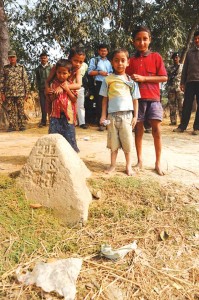 I met Aslam, a Bangladeshi in the Indian village of Haripukur. He had sauntered across the border to meet his friends and relatives. I told him I wanted to visit his village and he readily agreed to escort me. He took me through the winding lanes of Haripukur and soon we reached a narrow and precarious path behind a mud house.
I met Aslam, a Bangladeshi in the Indian village of Haripukur. He had sauntered across the border to meet his friends and relatives. I told him I wanted to visit his village and he readily agreed to escort me. He took me through the winding lanes of Haripukur and soon we reached a narrow and precarious path behind a mud house.
On one side was the mud wall of the house and on the other a pond. I watched my steps as I followed Aslam, ten feet away he stopped at a concrete pillar. I smiled at him. It was the border pillar marking the sovereign domains of two countries. His hands carved a line in the air as he traced the alignment of border. From the pillar I took one step and I was in another country, in Bangladesh.
The porosity of the eastern frontier is so mind boggling that it should be made mandatory for bureaucrats, policy makers and politicians in key ministries dealing with security issues to visit these locations to appreciate and familiarize themselves with ground realities.
Later along with Aslam I crossed over back into India. People along bordering villages do this on a regular basis every single day. They simply walk across from Bangladesh into India. The villages are just next to each other. The houses are cheek by jowl. The people live in such close proximity that it become difficult for BSF to distinguish between Bangladeshis and Indians. Now consider how easy it is for a terrorist to walk in and to take shelter in a house in a border village. Locals revealed that this is what illegal migrants do. They cross over, take shelter in a safe house, stay there for a period of time to get their Indian citizenship documentation, basically a ration card and carry on to Kolkata and then to various parts of the country. This is how, for instance, visible Bangladeshi presence has grown in Indian cities – the rickshaw-wallahs in Noida, domestic workers in Jaipur and Delhi.
Here are snippets of my recorded conversations with Aslam, who told me that he spends most of his time in the Indian border village of Haripukur.
“Q: Where do you stay?
A: In Raibagh, in Bangladesh.
Q: So you live nearby enabling you to easily cross over to India?
A: Yes we can, so can our relatives.”
Unless, a massive border development programme is undertaken with a missionary zeal, Indias border dwellers will find it difficult to give up smuggling as a vocation. After all hunger and survival are primeval in nature and overshadows concepts such as national security and national interest.
In border villages like Haripukur there are village houses on the zero line, hugging each other. This is a common feature of the South Dinajpur stretch of the India-Bangladesh border. This is a border area where fencing cannot be done unless the border populations are moved back from the zero line and buffer zone of at least a kilometer is created. But villagers are against any such move. “It would be a great inconvenience for us since all our properties and lands are here. Our earnings come from our lands, so how can we shift back?” said Sheikh Younis, a resident of Haripukur village.
Terrorists don’t need an elaborate plan to infiltrate. They just have to reach a border village on the Bangladeshi side which is contiguous with a border village on the Indian side, like the village of Haripukur that stands between two countries. And walk in like I did along with local facilitators. Haripukur exemplifies the problem of effectively dominating the India-Bangladesh border. Most houses built along the zero line alignment have doors built on rear walls for easy accessibility from Bangladesh and vice versa.
Here it’s impossible for an outsider to figure out where the border begins and where it ends. At times even BSF patrols are confused and have to tread cautiously. As I walked on the border tracks I could understand and visualize the operational problems that the BSF faces in ensuring that no illegal migration takes place through such border villages.
I came across a house on the zero line, in the Indian side, stocked with phensydyl bottles. This cough syrup is consumed as an intoxicant in Bangladesh because of its strict prohibition laws. By now that stock would have already found its way to Bangladesh in small consignments and a fresh stock dispatched from Kolkata would have replaced it. Clearly, the proximity of Indian and Bangladeshi village houses is a boon for smugglers and infiltrators.
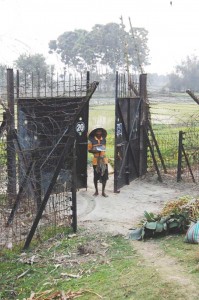 The livelihoods of the border villagers depend on smuggling and they are incapable at the moment to comprehend the security implications of their activities. Besides, the local administration is so deeply involved in these activities. Again, therefore, is it any surprise that local civil administration and the police don’t find it essential to inform and educate the border dwellers on national security concerns. Is it any surprise, therefore, that there is no incentivized reward system for locals to cooperate with the BSF in sharing real time human intelligence?
The livelihoods of the border villagers depend on smuggling and they are incapable at the moment to comprehend the security implications of their activities. Besides, the local administration is so deeply involved in these activities. Again, therefore, is it any surprise that local civil administration and the police don’t find it essential to inform and educate the border dwellers on national security concerns. Is it any surprise, therefore, that there is no incentivized reward system for locals to cooperate with the BSF in sharing real time human intelligence?
“Smuggling is the only means for us to earn our livelihoods.” I heard this over and over again. It’s an incontrovertible truth because there is no employment option in most border areas. The truth is smuggling continues unabated even in areas where the fencing is complete. The fence does not take into account either human depravity or the extra-ordinarily varied geography of the border, which cuts through Indian and Bangladeshi towns, villages, houses, agriculture fields, ponds, rivers, vast scrubland and miles of char-lands created by the meandering Ganges.
Unless, a massive border development programme is undertaken with a missionary zeal, India’s border dwellers will find it difficult to give up smuggling as a vocation. After all hunger and survival are primeval in nature and overshadows concepts such as national security and national interest.
As we walk around Haripukur village I realized the truism that one can’t argue with geography, it simply is what it is. On the zero line I came across a Masjid, its rear wall in India, the rest of the structure in Bangladesh! Walking further I reached a narrow strip of land through the middle of a pond. I found out that the locals were aware of the border alignment.
As I walked on the narrow strip of land, voices behind me cautioned not to cross the half way mark because I could unintentionally step into Bangladesh and if anything happened they wouldn’t be able to help! An elderly Bangladeshi gentleman walked upto me at the halfway point to chat. He said for the border villagers, united by poverty and deprivation, nationality and sovereignty are alien concepts to them.
The Panchayat members confessed that Left parties and the state government help Bangladeshi migrants to get Indian citizenship documents. In return, the migrants vote for the CPI (M) in state and national elections.
He said the people from both sides cross over regularly, all the time. So, when New Delhi says that the border has been sealed, the reality is that you can break this seal by just walking across.
The Politics of Infiltration
Kanchakarpur is a border village a couple of hours away from Kolkata. Members of the village panchayat meet almost every day of the week, and one of their most prominent concerns are Bangladeshi infiltrators. “About six months back, an immigrant came to India with guns in a sack of sugar. Such small incidents happen, like a man was arrested by the police, an infiltrator, who was let off soon after once he had bribed the police. The infiltrators can even choose to swim across some of the water bodies which separate the two countries,” said Shishir Dutta, member of Kanchakarpur Panchayat.
The Panchayat members confessed that Left parties and the state government help Bangladeshi migrants to get Indian citizenship documents. In return, the migrants vote for the CPI (M) in state and national elections. “There are some people who have houses both in India and Bangladesh, who have managed to procure ration cards, etc., by paying bribes to the right people, and again there are Indians who haven’t got any of these, and are facing problems as they do not have the money to bribe the officials,” revealed Rashid Ali, member, Kanchakarpur Panchayat.
In Panpakuria, angry villagers displayed their APL cards, or Above Poverty Line ration cards given to them by the government. The villagers say they are desperately poor, and need BPL or Below Poverty Line cards, but they don’t get them. “Bangladeshi migrants or those associated with them get it easily. Because we are not with CPI (M) we don’t get it,” said Samsunara, a villager. “Cadres of Left parties are helping the migrants infiltrate and settle down by providing them with ration cards, BPL cards and monetary help. CPI (M) helps the immigrants,” said Ranjana Biswas, a community activist.
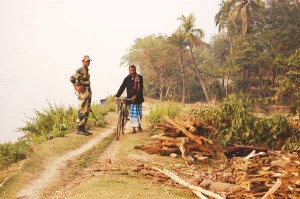 Along the border districts of West Bengal the presence of Bangladeshi immigrants is unmistakable. Prof Sunanda Sanyal of Ganamukti Parishad, a civil society organization, said, “It was easier in earlier times, in 1971 for example, when you could tell people from Bangladesh and India apart. Now this is no longer the case as Bangladeshis easily mix with the people here after infiltrating through the porous border. Even if you check their dialect it is no longer possible to tell them apart.” “The sinister part was that a minister of the Left Front used to encourage them, and as he was in charge of food, he issued ration cards to them, which helped them get on the voter’s list,” said Debabrata Bandhopadhyay.
Along the border districts of West Bengal the presence of Bangladeshi immigrants is unmistakable. Prof Sunanda Sanyal of Ganamukti Parishad, a civil society organization, said, “It was easier in earlier times, in 1971 for example, when you could tell people from Bangladesh and India apart. Now this is no longer the case as Bangladeshis easily mix with the people here after infiltrating through the porous border. Even if you check their dialect it is no longer possible to tell them apart.” “The sinister part was that a minister of the Left Front used to encourage them, and as he was in charge of food, he issued ration cards to them, which helped them get on the voter’s list,” said Debabrata Bandhopadhyay.
Large numbers of Bangladeshi refugees came to India after partition. By 1948, over 12 lakh people had crossed over to West Bengal, Assam and Tripura. Sixty years after Independence that number has gone up to 20 million, according to the Home Ministry. “First type of migrants – those who come for money – are not a threat to national security. But there’s another category called Bihari migrants. This section of people are a real threat to national security, as people who fought against India and Bangladesh, and whom Pakistan refused to take in due to demographic reasons settled in India with an anti-Indian attitude which has persisted into the second or even third generation immigrants. They are a threat to our security,” explained Bandhopadhyay.
Over the last six decades the demographic profile of West Bengal’s border districts has changed dramatically.
Darjeeling: Hindus (240%) Muslim (1235%)
Maldah: Hindus (174%) Muslim (372 %)
Murshidabad: Hindus (175%) Muslim (294 %)
Nadia: Hindus (285%) Muslim (357 %)
Source: 2001 Census Report
From 1951 to 2001, there has been a rapid growth of Muslim enclaves along the entire stretch of the Bengal-Bangladesh border. This has happened despite the increase in BSF deployment along the border over the last three decades. As long as Bangladeshi migrants are seen as politically expedient, India’s eastern frontier will continue to remain one of its biggest national security threats. “The Bihari Muslim population in East Pakistan (Bangladesh) who supported Pakistan, fought alongside Pakistan, was interned at three concentration camps near Dhaka. There were more than a million interns, but that number has dwindled to about a lakh or so from 1971-2008.
Large numbers of Bangladeshi refugees came to India after partition. By 1948, over 12 lakh people had crossed over to West Bengal, Assam and Tripura. Sixty years after Independence that number has gone up to 20 million, according to the Home Ministry.
The one million should have increased to two million or so by now if one goes by the rate of population growth in the region. It is safe to conclude that almost everyone from these internment camps migrated to West Bengal. One route where Bengali was not spoken was Chicken’s Neck at North Dinajpur, where Bengali, Hindi as well as Urdu are spoken. And once they gain entry into India, the rest of India is also open to them. Another more sophisticated route was Jalandi-Karimpur region, the Nadia-Murshidabad border to South 24 Parganas, straight to Kolkata at Kidderpore where a large section of the population speak Urdu or Watgunj, Metiabruz area of Kolkata.
It was in this area where Wajid Ali Shah, the 10th and last nawab of the princely kingdom of Awadh (Oudh) in present day Uttar Pradesh in India, settled after his kingdom was peacefully annexed by the colonial British administration in 1856. So the Bihari Muslims of Bangladesh who have settled in the urdu speaking belt of Kolkata are a real threat to national security, as people who fought against India and Bangladesh, and whom Pakistan refused to take in due to demographic reasons settled in India with an anti-Indian attitude which has persisted into the second or even third generation immigrants. They are a threat to our security,” said Bandhopadhyay.
In Tripura the border pillars separating India and Bangladesh are mute spectators to the infiltration across the 850 kilometre long border in the state. Many illegal migrants make their way to Agartala, the capital of Tripura. “It’s true that lots of Bangladeshis come through the border but it’s not possible by looking at the person to tell he is just a worker or a terrorist,” said a villager in a border village. Infiltration is an almost routine affair along unfenced portions of the border. A fact acknowledged and accepted by local politicians like Sudip Roy Burman, a member of Tripura’s legislative assembly from Agartala: “There is no doubt that hundreds of Bangladeshis cross the border each and every day. One wonders how that happens resulting in hundreds of Bangladeshis name in the electoral role, in spite of the fact that their names do exist in Bangladesh’s electoral list also.”
In Tripura’s borderland new fences are being built. But many villages are still dangerously close to the boundary, their proximity open to exploitation by terror groups. In fact, hundreds of Bangladeshis cross over as daily wage workers and at the end of the day, they go back to their villages in Bangladesh. “They cross over from the border. They come after breakfast, ply their rickshaws, have lunch here and go back before nightfall and we locals starve,” said a rickshaw puller in Agartala. More than 10,000 families have been displaced to make way for the border fence, and another 5,000 families face eviction. Citizen’s groups are fighting for proper rehabilitation and compensation of the affected families.




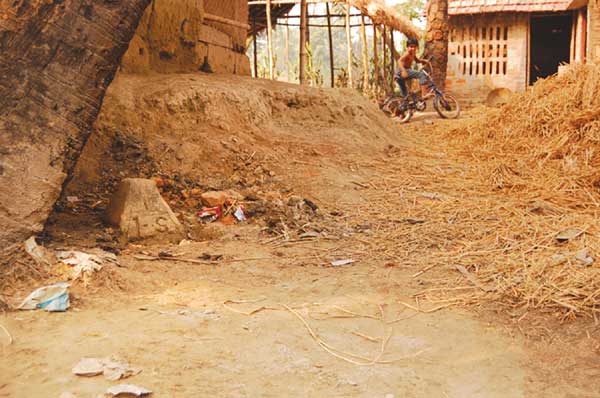
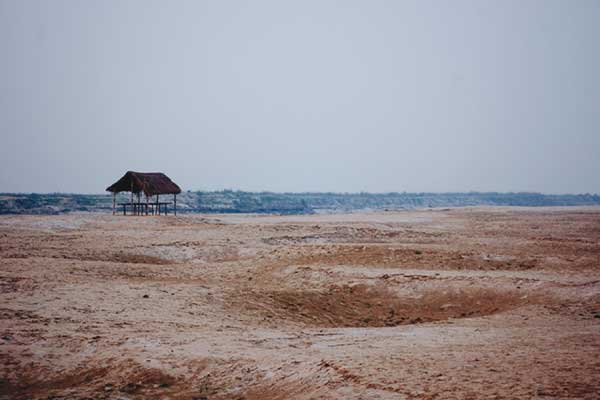

Dear Sir,
Thanks for the article. However there seems to be a remarked lack of empiricism in your conceptualization of the issue of borderland and its nuances. The statist parlance that you echo in every breath of this long diatribe against the Bangladeshi leaves spaces of concerns about understanding migration across the border for various other purposes other than ‘smuggling and infiltration’.
As a researcher working in this field I find myself disagreeing with the inglorious picture you paint where the poor are criminalised and the rent seeking capitalist regimes in Indian locations remain unquestioned about their propinquity to employ such infiltrators or the poor Indian state that can spend more than Rs. 2.5 lakhs on defense expenditure but still pay a BSF constable a paltry sum of Rs. 4680 per month enticing him to indulge in corruption and turn a blind eye to the mobility of people.
Instead of your diatribe against Bangladeshis as a whole, it would have been a much better paper had you attempted a structural analysis of the issue at hand.
Regards.
what do u thnk about urself.????how can u say that u have dfteaeed indians???see..ur nation is depending on our nation for a satellite and many other needs and u don’t have anything. so be in ur limit and if u crossed it, then u will be going to face dark mornings ahead .we also dont want war, bt peace.so enrich ur knowledge not by attacking other nation’s sites. ..so try to enrich ur knowlege 4 ur country’s development,a msg frm indian brother .thank u .